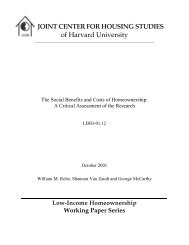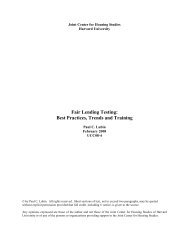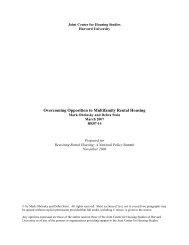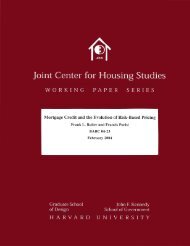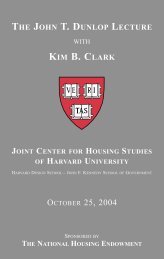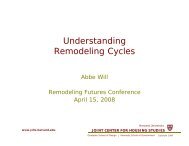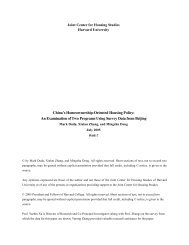please do not cite or circulate without permission of the authors
please do not cite or circulate without permission of the authors
please do not cite or circulate without permission of the authors
You also want an ePaper? Increase the reach of your titles
YUMPU automatically turns print PDFs into web optimized ePapers that Google loves.
The estimated coefficients f<strong>or</strong> <strong>the</strong> ring variables and <strong>the</strong>ir standard err<strong>or</strong>s are<br />
shown in Figure 7. The complete model specification with <strong>the</strong> coefficients f<strong>or</strong> <strong>the</strong><br />
structural variables is included in Appendix A. These structural variables have <strong>the</strong><br />
expected signs. 16 The per unit sales price is higher if a building is larger <strong>or</strong> newer, located<br />
on a c<strong>or</strong>ner, <strong>or</strong> includes a garage. The price is lower if <strong>the</strong> building is vandalized <strong>or</strong><br />
aban<strong>do</strong>ned. The building class dummies are also consistent with expectations. Sales<br />
prices f<strong>or</strong> most <strong>of</strong> <strong>the</strong> building types are lower than those f<strong>or</strong> single-family attached<br />
homes (<strong>the</strong> omitted categ<strong>or</strong>y). One result, perhaps counter-intuitive, is that <strong>the</strong> estimated<br />
impact <strong>of</strong> <strong>the</strong> dummy variable indicating that <strong>the</strong> building has undergone a maj<strong>or</strong><br />
alteration pri<strong>or</strong> to sale is statistically insignificant. This result may reflect <strong>the</strong> fact that<br />
buildings that have undergone such maj<strong>or</strong> alterations are generally in w<strong>or</strong>se shape and<br />
lower-priced pri<strong>or</strong> to renovation in ways that are <strong>not</strong> captured by our data. 17<br />
The key coefficients, those on <strong>the</strong> ring dummy variables, are presented in Figure<br />
7. Again, each <strong>of</strong> <strong>the</strong>se coefficients may be interpreted as <strong>the</strong> percentage difference<br />
between <strong>the</strong> price <strong>of</strong> properties within <strong>the</strong> rings and comparable properties located<br />
outside <strong>the</strong> rings but within <strong>the</strong> same community district. (The coefficient on Ring500,<br />
one year bef<strong>or</strong>e completion, f<strong>or</strong> instance suggests that properties located within 500 feet<br />
<strong>of</strong> a future Partnership <strong>or</strong> Nehemiah project one year pri<strong>or</strong> to completion sold f<strong>or</strong> 10.4<br />
percent less than comparable properties beyond 500 feet but in <strong>the</strong> same community<br />
district.)<br />
The first point to <strong>not</strong>e is that all <strong>the</strong> coefficients are negative and virtually all are<br />
statistically significant. Consistent with <strong>the</strong> uncontrolled results set f<strong>or</strong>th in Figure 6, that<br />
is, prices <strong>of</strong> properties located in <strong>the</strong> rings are significantly lower than <strong>the</strong> prices <strong>of</strong><br />
comparable properties located in <strong>the</strong>ir community district, both bef<strong>or</strong>e and after project<br />
completion. The second point to <strong>not</strong>e is that <strong>the</strong> coefficients generally get smaller over<br />
time. Prices in <strong>the</strong> rings, that is, rise over time relative to prices in <strong>the</strong> larger community<br />
16 The odd-shape and extension variable are included to capture any irregularities in <strong>the</strong> calculation <strong>of</strong><br />
square footage.<br />
17 It is w<strong>or</strong>th mentioning <strong>the</strong> statistically significant coefficients on <strong>the</strong> dummy variables indicating if <strong>the</strong><br />
age <strong>or</strong> size <strong>of</strong> a building is missing. In general, <strong>the</strong>se suggest that <strong>the</strong> buildings f<strong>or</strong> which age is missing are<br />
older than o<strong>the</strong>rs and <strong>the</strong> buildings f<strong>or</strong> which square footage is missing are larger. The con<strong>do</strong>miniums f<strong>or</strong><br />
which square footage is missing (90 percent <strong>of</strong> sales missing square feet) are also larger, but somewhat less<br />
so. In total, just over one percent <strong>of</strong> property sales did <strong>not</strong> indicate square footage and three percent did <strong>not</strong><br />
indicate age.<br />
21



